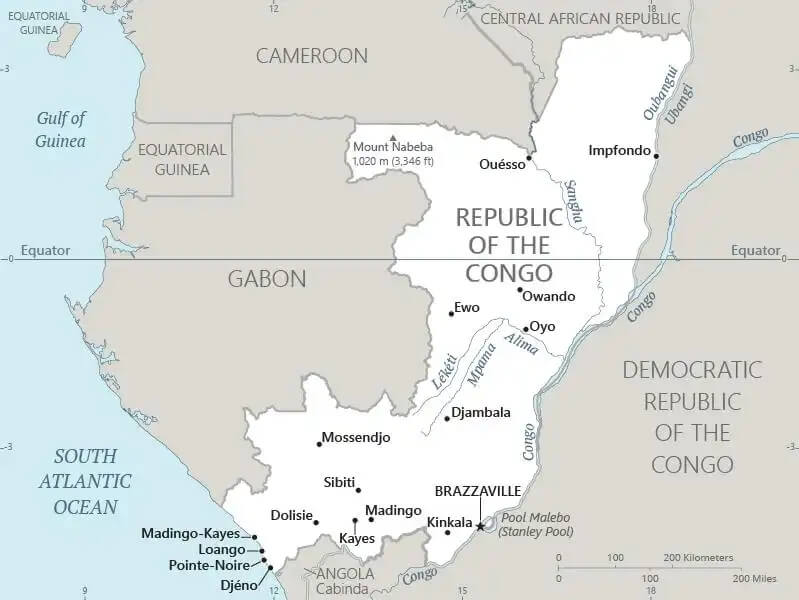World Book
Republic of the Congo
World Book Index
58


With a score of 58, the country is ranked 106th out of 158 countries in the World Book ranking. (more information)
Introduction
Background
Upon independence in 1960, the former French region of Middle Congo became the Republic of the Congo. A quarter-century of experimentation with Marxism was abandoned in 1990 and a democratically elected government took office in 1992. The Republic of Congo is one of Africa's largest petroleum producers.
Geography
Area
total : 342,000 sq km
land: 341,500 sq km
water: 500 sq km
Climate
tropical; rainy season (March to June); dry season (June to October); persistent high temperatures and humidity; particularly enervating climate astride the Equator
Natural resources
petroleum, timber, potash, lead, zinc, uranium, copper, phosphates, gold, magnesium, natural gas, hydropower
People and Society
Population
total: 6,097,665 (2024 est.)
Ethnic groups
Kongo (Bakongo) 40.5%, Teke 16.9%, Mbochi 13.1%, foreigner 8.2%, Sangha 5.6%, Mbere/Mbeti/Kele 4.4%, Punu 4.3%, Pygmy 1.6%, Oubanguiens 1.6%, Duma 1.5%, Makaa 1.3%, other and unspecified 1% (2014-15 est.)
Languages
French (official), French Lingala and Monokutuba (trade languages), many local languages and dialects (of which Kikongo is the most widespread)
Religions
Roman Catholic 33.1%, Awakening Churches/Christian Revival 22.3%, Protestant 19.9%, Salutiste 2.2%, Muslim 1.6%, Kimbanguist 1.5%, other 8.1%, none 11.3% (2007 est.)
Population growth rate
2.38% (2024 est.)
Government
Government type
presidential republic
Capital
name: Brazzaville
Executive branch
chief of state: President Denis SASSOU-Nguesso (since 1997)
head of government: Prime Minister Anatole Collinet MAKOSSO (since 12 May 2021)
Diplomatic representation in the US
chief of mission: Ambassador (vacant); Chargé d'Affaires Firmine BOUITY (since 6 September 2025)
Diplomatic representation from the US
chief of mission: Ambassador (vacant); Chargé d’Affaires Amanda S. JACOBSEN (since 18 July 2025)
Economy
Economic overview
primarily an oil- and natural resources-based economy; recovery from mid-2010s oil devaluation has been slow and curtailed by COVID-19; extreme poverty increasing, particularly in southern rural regions; attempting to implement recommended CEMAC reforms; increasing likelihood of debt default
Real GDP (purchasing power parity)
$39.147 billion (2024 est.)
$38.163 billion (2023 est.)
$37.448 billion (2022 est.)
Real GDP per capita
$6,200 (2024 est.)
$6,200 (2023 est.)
$6,200 (2022 est.)
Exports
$7.752 billion (2021 est.)
$4.67 billion (2020 est.)
$7.855 billion (2019 est.)
Exports - partners
China 46%, UAE 23%, India 6%, Saudi Arabia 5%, Portugal 3% (2023)
Exports - commodities
crude petroleum, refined copper, gold, wood, refined petroleum (2023)
Imports
$4.487 billion (2021 est.)
$3.279 billion (2020 est.)
$4.945 billion (2019 est.)
Imports - partners
China 24%, Angola 20%, Gabon 9%, France 6%, UAE 5% (2023)
Imports - commodities
ships, poultry, garments, iron pipes, refined petroleum (2023)
Human Development Index
The country's Human Development Index (HDI) is 0.649, ranking it 138th out of 193 countries tested. (more information)
World Happiness Report
The World Happiness Report ranked the country 94th out of 158 countries tested with a score of 5.221. (more information)



